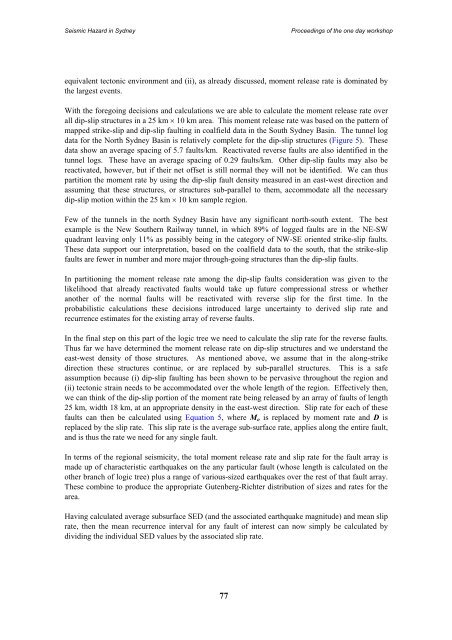Landslides in the Sydney Basin - Geoscience Australia
Landslides in the Sydney Basin - Geoscience Australia
Landslides in the Sydney Basin - Geoscience Australia
- No tags were found...
You also want an ePaper? Increase the reach of your titles
YUMPU automatically turns print PDFs into web optimized ePapers that Google loves.
Seismic Hazard <strong>in</strong> <strong>Sydney</strong>Proceed<strong>in</strong>gs of <strong>the</strong> one day workshopequivalent tectonic environment and (ii), as already discussed, moment release rate is dom<strong>in</strong>ated by<strong>the</strong> largest events.With <strong>the</strong> forego<strong>in</strong>g decisions and calculations we are able to calculate <strong>the</strong> moment release rate overall dip-slip structures <strong>in</strong> a 25 km × 10 km area. This moment release rate was based on <strong>the</strong> pattern ofmapped strike-slip and dip-slip fault<strong>in</strong>g <strong>in</strong> coalfield data <strong>in</strong> <strong>the</strong> South <strong>Sydney</strong> Bas<strong>in</strong>. The tunnel logdata for <strong>the</strong> North <strong>Sydney</strong> Bas<strong>in</strong> is relatively complete for <strong>the</strong> dip-slip structures (Figure 5). Thesedata show an average spac<strong>in</strong>g of 5.7 faults/km. Reactivated reverse faults are also identified <strong>in</strong> <strong>the</strong>tunnel logs. These have an average spac<strong>in</strong>g of 0.29 faults/km. O<strong>the</strong>r dip-slip faults may also bereactivated, however, but if <strong>the</strong>ir net offset is still normal <strong>the</strong>y will not be identified. We can thuspartition <strong>the</strong> moment rate by us<strong>in</strong>g <strong>the</strong> dip-slip fault density measured <strong>in</strong> an east-west direction andassum<strong>in</strong>g that <strong>the</strong>se structures, or structures sub-parallel to <strong>the</strong>m, accommodate all <strong>the</strong> necessarydip-slip motion with<strong>in</strong> <strong>the</strong> 25 km × 10 km sample region.Few of <strong>the</strong> tunnels <strong>in</strong> <strong>the</strong> north <strong>Sydney</strong> Bas<strong>in</strong> have any significant north-south extent. The bestexample is <strong>the</strong> New Sou<strong>the</strong>rn Railway tunnel, <strong>in</strong> which 89% of logged faults are <strong>in</strong> <strong>the</strong> NE-SWquadrant leav<strong>in</strong>g only 11% as possibly be<strong>in</strong>g <strong>in</strong> <strong>the</strong> category of NW-SE oriented strike-slip faults.These data support our <strong>in</strong>terpretation, based on <strong>the</strong> coalfield data to <strong>the</strong> south, that <strong>the</strong> strike-slipfaults are fewer <strong>in</strong> number and more major through-go<strong>in</strong>g structures than <strong>the</strong> dip-slip faults.In partition<strong>in</strong>g <strong>the</strong> moment release rate among <strong>the</strong> dip-slip faults consideration was given to <strong>the</strong>likelihood that already reactivated faults would take up future compressional stress or whe<strong>the</strong>rano<strong>the</strong>r of <strong>the</strong> normal faults will be reactivated with reverse slip for <strong>the</strong> first time. In <strong>the</strong>probabilistic calculations <strong>the</strong>se decisions <strong>in</strong>troduced large uncerta<strong>in</strong>ty to derived slip rate andrecurrence estimates for <strong>the</strong> exist<strong>in</strong>g array of reverse faults.In <strong>the</strong> f<strong>in</strong>al step on this part of <strong>the</strong> logic tree we need to calculate <strong>the</strong> slip rate for <strong>the</strong> reverse faults.Thus far we have determ<strong>in</strong>ed <strong>the</strong> moment release rate on dip-slip structures and we understand <strong>the</strong>east-west density of those structures. As mentioned above, we assume that <strong>in</strong> <strong>the</strong> along-strikedirection <strong>the</strong>se structures cont<strong>in</strong>ue, or are replaced by sub-parallel structures. This is a safeassumption because (i) dip-slip fault<strong>in</strong>g has been shown to be pervasive throughout <strong>the</strong> region and(ii) tectonic stra<strong>in</strong> needs to be accommodated over <strong>the</strong> whole length of <strong>the</strong> region. Effectively <strong>the</strong>n,we can th<strong>in</strong>k of <strong>the</strong> dip-slip portion of <strong>the</strong> moment rate be<strong>in</strong>g released by an array of faults of length25 km, width 18 km, at an appropriate density <strong>in</strong> <strong>the</strong> east-west direction. Slip rate for each of <strong>the</strong>sefaults can <strong>the</strong>n be calculated us<strong>in</strong>g Equation 5, where M o is replaced by moment rate and D isreplaced by <strong>the</strong> slip rate. This slip rate is <strong>the</strong> average sub-surface rate, applies along <strong>the</strong> entire fault,and is thus <strong>the</strong> rate we need for any s<strong>in</strong>gle fault.In terms of <strong>the</strong> regional seismicity, <strong>the</strong> total moment release rate and slip rate for <strong>the</strong> fault array ismade up of characteristic earthquakes on <strong>the</strong> any particular fault (whose length is calculated on <strong>the</strong>o<strong>the</strong>r branch of logic tree) plus a range of various-sized earthquakes over <strong>the</strong> rest of that fault array.These comb<strong>in</strong>e to produce <strong>the</strong> appropriate Gutenberg-Richter distribution of sizes and rates for <strong>the</strong>area.Hav<strong>in</strong>g calculated average subsurface SED (and <strong>the</strong> associated earthquake magnitude) and mean sliprate, <strong>the</strong>n <strong>the</strong> mean recurrence <strong>in</strong>terval for any fault of <strong>in</strong>terest can now simply be calculated bydivid<strong>in</strong>g <strong>the</strong> <strong>in</strong>dividual SED values by <strong>the</strong> associated slip rate.
















